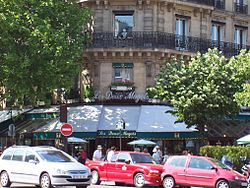Boulevard Saint-Germain: Difference between revisions
Jenny Wong (talk | contribs) no need→History |
Jenny Wong (talk | contribs) no need→History |
||
| Line 10: | Line 10: | ||
In the 17th Century, the Saint-Germain quarter became a major site for nobel town houses, or ''hôtels particuliers''. This reputation continued throughout the nineteenth century, where the old aristocracy of the Saint-Germain quarter is frequently contrasted with the new upper [[bourgeoisie]] of the [[Rive Droite|Right bank]], having their homes on the [[Boulevard Saint-Honoré]] or on the [[Champs-Élysées]] (as noted, for example, in the novels of [[Honoré de Balzac]].) |
In the 17th Century, the Saint-Germain quarter became a major site for nobel town houses, or ''hôtels particuliers''. This reputation continued throughout the nineteenth century, where the old aristocracy of the Saint-Germain quarter is frequently contrasted with the new upper [[bourgeoisie]] of the [[Rive Droite|Right bank]], having their homes on the [[Boulevard Saint-Honoré]] or on the [[Champs-Élysées]] (as noted, for example, in the novels of [[Honoré de Balzac]].) |
||
From the |
From the 1930s on, Saint-Germain has been associated with its nightlife, cafés and students (the boulevard traverses the [[Quartier Latin]] (or "Latin quarter"). Home to a number of famous [[café]]s, such as [[Les Deux Magots]] and [[Café de Flore]], the Saint-Germain quarter was the center of the [[existentialism]] movement (associated with [[Jean-Paul Sartre]] and [[Simone de Beauvoir]]). |
||
The Boulevard Saint-Germain is today a thriving high-end shopping street with stores from [[Armani]] and [[Rykiel]]. Nearby is the ''Institut d'Etudes Politiques'' (or "Science-Po" for short), one of the finest political science schools in Europe. |
The Boulevard Saint-Germain is today a thriving high-end shopping street with stores from [[Armani]] and [[Rykiel]]. Nearby is the ''Institut d'Etudes Politiques'' (or "Science-Po" for short), one of the finest political science schools in Europe. |
||
Revision as of 14:15, 11 July 2006



The Boulevard Saint-Germain is a major street in Paris on the Left Bank (south side) of the Seine river. It curves in an arc from the Pont de Sully in the east (the bridge at the edge of the Île Saint-Louis) to the Pont de la Concorde (the bridge to the Place de la Concorde) in the west and traverses the 5th, 6th and 7th arrondissements. At its midpoint, the Boulevard Saint-Germain is traversed by the north-south Boulevard Saint-Michel.
History
The Boulevard Saint-Germain derives its name from the former abbey of Saint-Germain-des-Prés which stood here in the Middle Ages. The area around the boulevard is also referred to as the Faubourg Saint-Germain, or "suburb" of Saint-Germain which developed to the west of the abbey.
In the 17th Century, the Saint-Germain quarter became a major site for nobel town houses, or hôtels particuliers. This reputation continued throughout the nineteenth century, where the old aristocracy of the Saint-Germain quarter is frequently contrasted with the new upper bourgeoisie of the Right bank, having their homes on the Boulevard Saint-Honoré or on the Champs-Élysées (as noted, for example, in the novels of Honoré de Balzac.)
From the 1930s on, Saint-Germain has been associated with its nightlife, cafés and students (the boulevard traverses the Quartier Latin (or "Latin quarter"). Home to a number of famous cafés, such as Les Deux Magots and Café de Flore, the Saint-Germain quarter was the center of the existentialism movement (associated with Jean-Paul Sartre and Simone de Beauvoir).
The Boulevard Saint-Germain is today a thriving high-end shopping street with stores from Armani and Rykiel. Nearby is the Institut d'Etudes Politiques (or "Science-Po" for short), one of the finest political science schools in Europe.
At n° 184 is the world's oldest Geographical Society, founded in 1821 by von Humboldt, Chateaubriand, Dumont d’Urville, Champollion among others has had its headquarters here since 1878. The entrance is marked by two gigantic caryatids representing Land and Sea. It was here, in 1879, that the construction of the Panama Canal was decided.
